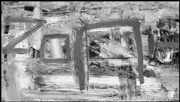ALFONSE BORYSEWICZ
Francine Seders Gallery, 6701 Greenwood N., 206-782-0355 11 a.m.-5 p.m. Fri- Sat.; 1-5 p.m. Sun. ends Sun., Dec. 1
IN THE CURRENT art-gallery world, the only kind of overtly Christian artists considered acceptable are generally folk artists—whose religious beliefs are seen as another aspect of their charmingly unselfconscious exoticism. But there is little room for an artist like Alfonse Borysewicz, a devout Roman Catholic (“I’m pretty much what you would call orthodox,” he says) who is engaged with both the intricacies of 20th-century theology and a thoroughly modern, abstract painting style. Borysewicz has no gallery representation in New York, where the 45-year-old former seminarian lives with his wife and two children. And since the institutional church shows little interest in extending its rich historical involvement into anything remotely associated with modernism, Borysewicz is an artist without a home. “Actually, I’m almost literally homeless,” he says with a laugh.
Not that he is without admirers. He has received a Guggenheim Fellowship in painting, has drawn praise from The New York Times for his fine brushwork (though in fact he almost never touches a brush, using a palette knife almost exclusively), and has a growing fan base in Seattle. He’s currently having his second main gallery show at Francine Seders Gallery. Pat Scott of Seders says that while sales have been a bit slow, Borysewicz’s work has gotten a strong response from local artists, including Laurie Chambers and Fay Jones. Jones has bought a number of his pieces and showed up at the opening of the current show to praise his paintings’ strong “inner light.”
The large-scale oil paintings on view at Seders are part of a series Borysewicz calls the “theological alphabet”: M(ary), C(hrist Solstice), etc. This series reflects his recent decision to take his art in a more explicitly Christian direction. Earlier work that he now calls “inhibited, not completely honest” (he has been painting steadily since the mid-’80s), obscured its source of inspiration in a tasteful minimalism.
Borysewicz points out specific associations some pieces have for him—Christ spelled backward, for example, to signify how God, reflected in the believer, forms a complex, imperfect mirror image—but there are no prefabricated interpretations here. The paintings lead to an extended, open-ended contemplation of the painter’s motivations. The rough, vigorous strokes and often reckless color combinations seem to show Borysewicz’s faith not as some serene and static state of mind, but as a messy, ongoing, and very human process. The title of Icon is awkwardly scrawled on a background of garish reds and oranges, restlessly worked and reworked with Borysewicz’s palette knife, for an effect of feverish unrest far removed from the timeless perfection of the traditional gold-leafed religious object. The white C of C(hrist Solstice) heralds a scratchy black mass that on close inspection appears to be blotting out another composition in sunny yellows, perhaps representing an obedience to God that eclipses the more immediate pleasures of the ego.
Given how accessible the work is to non-Christians like me, there is a temptation to take the doctrinal content as more inclusive than it is, a temptation Borysewicz understands well. “Our multicultural world requires placating,” he writes in Image magazine, “and in it, holding onto dogma can be seen as not merely unfashionable, but downright belligerent.” But Borysewicz doesn’t want to be seen as “spiritual,” a term that has become associated with gooey, faddish philosophies that promote “self-esteem” but require no serious commitment or sacrifice. Borysewicz’s dogmatic Christianity is not an entirely comfortable presence in a secular gallery.
It has also been less than terrific for his career, since the art world prefers “edginess” of a more familiar kind, e.g., work that provides a banal shock with extreme and/or surreal sexuality and violence. (The current show by David Brody at Esther Claypool, with its pissing schoolgirls and female bodies reduced to breasts, vaginas, and anuses floating in space, is a fine case in point.) While the image of Jesus has been so commonly appropriated that it has long since lost its transgressive bang, reverence seems to be a greater taboo in the chummy left-wing milieu of the the art world. Seizing gleefully on priestly pedophilia or the latest idiotic statement by Jerry Falwell, the typical NPR-listening First Thursday regular condescendingly dismisses an entire tradition, while being completely ignorant of the rich history of Christian intellectualism from which Borysewicz draws. (The artist holds a master’s in theology.)
Not that Borysewicz is himself happy with the state of the Catholic Church, which he describes as a “beautiful tree with its roots cut off.” He sees the sexual-abuse scandals and crisis of leadership as evidence of the larger problem for the church: the lack of the essential breath of spirit, a further symptom of which is the absence of new Catholic art forms. At one point in our conversation, Borysewicz describes “zombies” who “come not to be fed but to consume,” and I ask him if he’s referring to gallery viewers or churchgoers. He pauses. “Well, both, actually.”
But Borysewicz’s religion is one of hope. His signature motif is a honeycomb pattern, produced with a laborious hand-stamping process, that occurs in almost all his paintings. “When the bees die, the comb remains,” he explains. “It’s a kind of immortality. My message, religious and secular, in both the theme and craft of painting, is ‘something survives.'”









